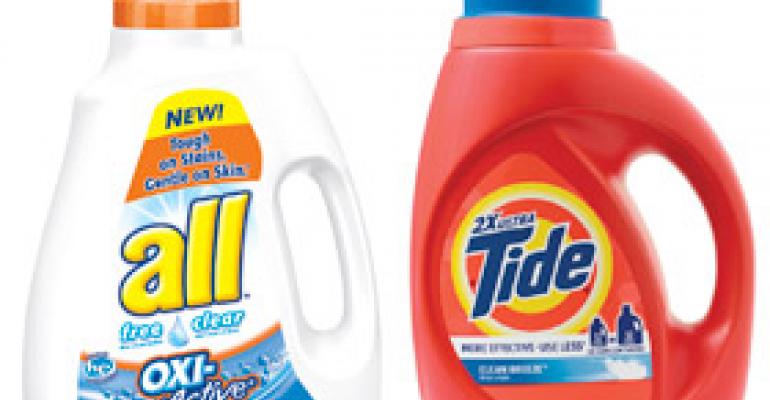Well-stocked laundry rooms are where more spots, splatters and smears are meeting their match as consumers justify the cost of brand-name detergents with what they're saving by caring for garments themselves.

Whereas pre-recession, Americans wouldn't think twice about tossing a less-than-perfect shirt in the Goodwill bin or shipping it off to the dry cleaner, today it's all about wardrobe preservation.
“With the economic circumstances most families are facing, they're cutting out dry cleaning, and with increased cotton prices, they're taking better care of their clothes instead of buying new,” said Kris Burdis, business manager for United Supermarkets, Lubbock, Texas.
Equipped with an arsenal of pretreaters, laundry boosters and specialized detergents for jobs spanning the delicate to downright dirty, consumers are finding that stains don't stand a chance. In fact, interest in pretreaters, laundry boosters and specialized detergents have led to the fastest growth in the laundry category with sales up 7% from 2008 to 2010, according to Mintel, Chicago.
“Consumers want to take charge in the laundry room and fix the problem themselves,” said Nancy Bock, vice president of consumer education at the Washington-based American Cleaning Institute (formerly The Soap and Detergent Association).
The close to 1 million Texans who shop United Supermarkets and its upscale Market Street and Hispanic-format Amigos banners each week are getting the most bang for their buck by matching detergent types to specific jobs, said Burdis.
Value brands Extra, Sun and private-label Supreme Clean — priced 20% below the national-brand equivalent — are bestsellers, along with 2x concentrated Tide, Gain, All Free Clear and Arm & Hammer.
Shoppers opt for larger sizes of detergent to help save money. Burdis does the math for them by featuring the price per load in sales circulars. He'll soon apply the same tactic at the shelf.
“A lot of our guests have four or five different types of laundry detergent in their laundry room,” he said, explaining that Tide might be used on dressier clothes, Supreme Clean for towels and dishrags and All Free Clear, which is free of perfumes and dyes, for delicate baby items.
Detergents specially formulated for high-efficiency washing machines are also gaining steam. HE detergents are lower sudsing and otherwise formulated for wash cycles that use less water since HE washers work with 20% to 66% of the water that standard machines do.
As of 2005, high-efficiency machines had a small but growing household penetration at 15%. But today most new washers are high-efficiency.
“For our clientele, high efficiency is increasingly the most popular segment, along with fragrance free,” said Stephen Brooks, assistant grocery buyer for Hiller's Markets, a seven-store, family-owned independent based in Southfield, Mich.
WHAT THE HEC?
Retailers have been challenged to juggle HE and standard versions of popular brands due to space constraints and consumer confusion about which formula to use in which machine. But that's changing now that dual compatibility detergents have been thrown into the mix. So-called HE-compatible or HEC formulas from companies like Purex and Method can either be used in standard or HE washers, Burdis explained. “The move will make things less confusing for the guests,” he said.
Laundry innovations also abound in an area that users haven't quite got the hang of: proper dosing. The ACI encourages consumers to stick with the dosage recommendations that researchers and developers have worked to pinpoint. Use too much soap and you may have to run the machine again to properly rinse clothes, said Bock. Use too little and a repeat cycle may also be necessary.
“You might use twice as much energy and water as you needed to get the results you were looking for,” she said.
Procter & Gamble will take the guesswork out of the equation with Tide Pods: a 3-in-1 product designed to clean, fight stains and brighten. The new formula is HE-compatible, twice as compact as current 2x Tide Liquid and encased in a film that dissolves in the wash, even in cold water.
At first United's Burdis was concerned the pods wouldn't break down in HE machines since they use less water, but Tide representatives convinced him otherwise.
United will carry four to six SKUs of the pods, including a 10-pod trial pack, in early 2012. Burdis expects the forms' convenience to appeal to consumers in the same way Cascade Complete ActionPacs for dishwashers have, he said.
“The Tide Pods will resonate with guests since you just pull the pod out and drop it in. You don't have to unscrew the cap and lift a 150-ounce bottle to pour it,” he said.
Dropps is another pre-measured pack that users can throw in the wash, but Burdis passed on them since they don't have the same brand recognition as Tide.
Laundry detergent users are a relatively loyal bunch with just 45% saying they've switched brands in the past year. Incidences dropped to 36% of those aged 45 and older. When it comes to the Tide detergents in particular, consumers are especially loyal, noted Burdis.
“The Tide guest is loyal to Tide since that's what mom and grandma used,” he said.
Coming Clean
Laundry detergent is a staple in nearly every household
| PRODUCT | HOUSEHOLD PENETRATION |
|---|---|
| Detergent | 98% |
| Bleach | 83% |
| Fabric softener | 78% |
| Laundry boosters | 52% |
| Spray starch | 28% |
SOURCE: Mintel Home Laundry Products report





